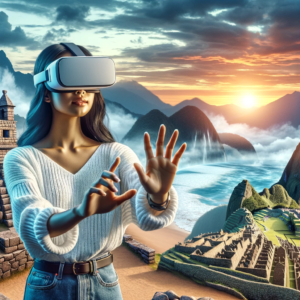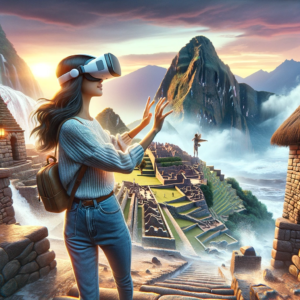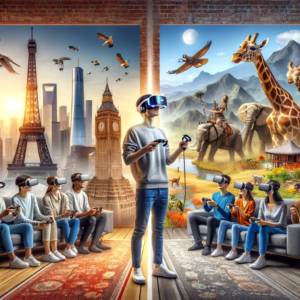Overview
Virtual reality (VR) is a game-changer in the quickly changing digital world of today’s travel industry. The introduction of “Virtual Reality Travel Experiences” has caused a profound change in how we view and investigate the world. This innovative approach removes obstacles and allows people to explore the globe from the comfort of their homes. Through lifelike simulations, virtual reality (VR) technology offers a unique insight into various cultures, landscapes, and historical locales. This allows anyone with a headset to access previously inaccessible parts of the world easily. This article aims to examine the extent and range of virtual reality’s influence on the travel sector, showing how it not only improves user experience but also democratizes access to international travel opportunities. We learn how virtual reality (VR) transforms future travel and cross-cultural interaction by exploring this nexus of technology and tourism.
Travel’s Development: From Actual to Virtual Trips
Fundamentally, travel has always been an integral aspect of human history, progressing from a means of survival to the rewarding endeavor of cultural inquiry and interchange. Foot-based expeditions were the first modes of transportation, and the destinations were constrained by physical stamina and geographic obstacles. Travel methods developed with civilizations, from tamed animals and carriages to the ground-breaking invention of steam-powered cars, trucks, and airplanes. This development significantly broadened the human perspective by making far-off places reachable.
The digital age ushered in a new era of travel. The development of the internet has made travel planning and scheduling simpler. With the advent of virtual tours, panoramic movies, and interactive maps, people could now see far-off places directly from their screens. But the development of virtual reality (VR) signaled a sea change in travel history.
The first virtual reality head-mounted display system was created in the 1960s when virtual reality originally emerged. For decades, though, it remained a specialized and untapped technology, mostly utilized in sophisticated simulations and military training. Advances in computing power, graphics, and sensor technologies led to a rebirth in VR technology in the early 21st century. The public can now more easily access VR technology thanks to the development of consumer-grade VR headsets.
VR travel is not only a notion anymore; it’s a quickly expanding industry. With high-definition, 360-degree cameras, users may virtually explore locations they have never been to by capturing and recreating scenes in breathtaking detail. VR technology has advanced to the point where users may engage with the virtual world in addition to seeing it; they can explore historical locations, peek around corners, and even experience the sounds and weather of their area.
The transition from tangible to virtual travel experiences significantly changes our understanding of and reactions to travel. VR provides an alternative or supplementary experience to physical travel, especially for individuals who cannot travel because of various constraints. Still, it can only partially replace physical travel’s tactile and emotional richness. Virtual reality (VR) technology promises to change our perception of exploration and cultural immersion by making the world easier to enter as it develops.

Understanding Virtual Reality Technology in Travel
Utilizing an advanced combination of hardware and software, virtual reality (VR) technology in travel allows users to be transported to virtual worlds that closely resemble real-world settings. Virtual reality technology mostly uses a headset, which is the most identifiable piece of gear. A 360-degree view of the virtual environment is possible with these headsets because they are outfitted with motion sensors and high-resolution screens to track the user’s head motions. To further improve the experience, many systems come with headphones or earbuds for immersive audio.
Another essential piece of gear for VR systems is a controller. With the help of these portable gadgets, users can engage with the virtual world more instinctively and naturally. With advanced controllers with haptic feedback and motion sensors, users may interact with the virtual world by pushing, throwing, and grasping objects. Travel experiences require this interaction since it gives customers the impression that they are visiting a new place.
Virtual reality travel experiences are enabled by finely detailed, high-quality 3D models of different destinations on the software side. These models frequently use real-world data, such as images and videos, to ensure accuracy and authenticity. These settings are rendered using sophisticated processes to provide lighting, shadows, and textures that are as realistic as possible.
VR travel offers a multisensory experience beyond visual and auditory perception. Though these are the main senses used, touch and smell are starting to be included in VR thanks to technological breakthroughs. Vests or outfits with haptic features can mimic physical feelings like the wind or the sun’s warmth. Similar to this, olfactory technology, while still in its infancy, seeks to create an immersive experience by simulating scents associated with various regions, such as the earthy perfume of a forest or the salty air of the seaside.
In conclusion, virtual reality travel uses high-tech hardware and software to produce immersive settings that appeal to various senses. This technology allows travelers to explore and engage with virtual versions of actual places, providing a novel and easily accessible travel experience.
Benefits of Virtual Reality Travel Experiences
Travelling in virtual reality (VR) has several advantages and is changing the way people think about tourism. These benefits address bigger societal and environmental issues in addition to satisfying an individual’s thirst for knowledge and adventure.
Cost-Effectiveness: The affordability of virtual reality travel is one of its biggest advantages. Conventional journey entails several fees, such as lodging, transportation, and daily expenditures. Conversely, VR travel needs a one-time purchase of a VR headset and the necessary software. Because of the significant cost load reduction, ‘travel’ becomes available to a greater proportion of the population who might not otherwise be able to afford traditional travel.
Accessibility: People with physical, medical, or other limitations that make traditional travel difficult or impossible can greatly benefit from virtual reality travel. Older adults, people with chronic illnesses, and people with limited mobility can all travel and see the world without putting in the physical effort that travel often requires. Virtual reality (VR) also makes it possible to explore and have adventures without running the danger of spreading disease during international events like pandemics when travel restrictions are in place.
Environmental Benefits: Virtual reality travel has a far smaller carbon footprint than traditional tourism. Since air travel contributes significantly to greenhouse gas emissions, virtual reality travel offers a more environmentally friendly option that doesn’t include driving. By reducing travel, you may lessen the impact of climate change and protect places where environmental degradation puts travelers at risk.
Virtual Reality Travel: VR travel is an effective tool for education and cross-cultural exchange since it breaks down language and geographical boundaries. It enables users to connect with and become fully immersed in many cultures, historical locations, natural wonders, and diverse lifestyles. This can promote empathy and cultural sensitivity while fostering a greater comprehension and respect for global variety.
In conclusion, virtual reality travel is an advancement in experiencing and learning about the globe, not only a substitute for traditional travel. Its advantages go beyond personal fulfilment; it also advances general social, educational, and environmental objectives.

VR Travel’s Drawbacks and Limitations
Virtual reality (VR) travel presents unique and immersive experiences, but several issues and restrictions must be resolved. The requirement for high-quality material is one of the main issues. Realistic and captivating virtual worlds demand a large investment in knowledge and technology. This is particularly true when it comes to authentically and captivatingly expressing the essence of various destinations.
Another important constraint is that travel can only partially be replicated by technology. Virtual reality mainly involves sight and hearing, but traditional trips involve other senses like taste, smell, and the tactile perception of various locations. Virtual reality travel may seem less real and immersive when these components still need to be included.
Accessibility is still a significant obstacle. VR travel experiences are only accessible to a very rich population because of the expense of VR technology, which is still prohibitive for many despite its declining cost. Because different socioeconomic classes frequently have unequal access to cutting-edge technology, this problem has global implications. Furthermore, the digital gap in tech proficiency and internet availability may hinder the broad use of VR travel, particularly in underdeveloped areas. These issues must be resolved for VR travel to reach its full potential as a truly inclusive and transformational medium.
Case Studies: Traveling with VR That Works
Several noteworthy case studies highlight how virtual reality travel may vividly bring historical sites and locations to life.
The Ancient Rome VR Tour: With the help of the Virtual Reality tour, visitors can experience Rome in the year 320 AD. Users marveled at the Colosseum and Roman Forum with never-before-seen detail, reporting a strong sensation of presence in the ancient world. Responses highlighted how the educational value deepened their awareness of Roman history, architecture, and the spectacle’s visual impact.
Journey to Machu Picchu: This all-encompassing encounter whisks guests to the renowned Incan stronghold. The VR tour was commended by tourists who cannot physically complete the arduous route for offering a genuine yet accessible experience. They noted that the VR experience increased their respect for Incan history and the site’s natural beauty and inspired them to learn more about different civilizations worldwide.
These illustrations show how VR has the potential to improve cultural understanding, increase accessibility to world heritage sites, and simulate travel.
The Future of Virtual Reality in Tourism
Virtual reality (VR) holds revolutionary potential for the travel industry. We may anticipate increasingly more participatory and immersive VR experiences as the technology develops. Artificial intelligence (AI) integration will customize travel experiences by customizing virtual tours to suit each person’s interests and preferences. Improved interaction will enable users to interact with virtual settings more easily; they might even be able to change how their virtual adventures unfold. Furthermore, a wider audience can access these experiences as virtual reality technology becomes more widely available and affordable, democratizing travel experiences worldwide. The advancement of technology will not only enhance conventional tourism but also pave the way for new global exploration opportunities.
Conclusion
In summary, virtual reality has the power to redefine travel completely. Virtual reality (VR) increases inclusivity and accessibility to the world by overcoming logistical and physical limitations. It provides a responsible substitute for traditional trips by mitigating the negative environmental effects of its sustainable approach. Virtual reality also acts as an auxiliary tool, offering experiences that precede real-world pilgrimage or allow users to relive special moments. This technology is more than an innovation; it’s a doorway to global comprehension and cultural immersion, changing how we interact, experience, and learn about many locations and cultures worldwide.
